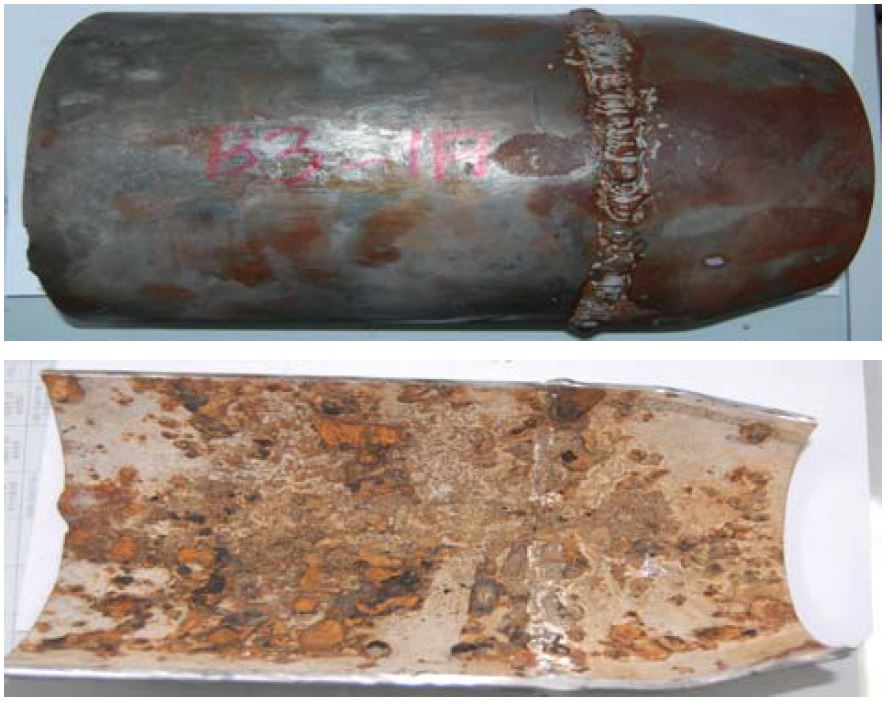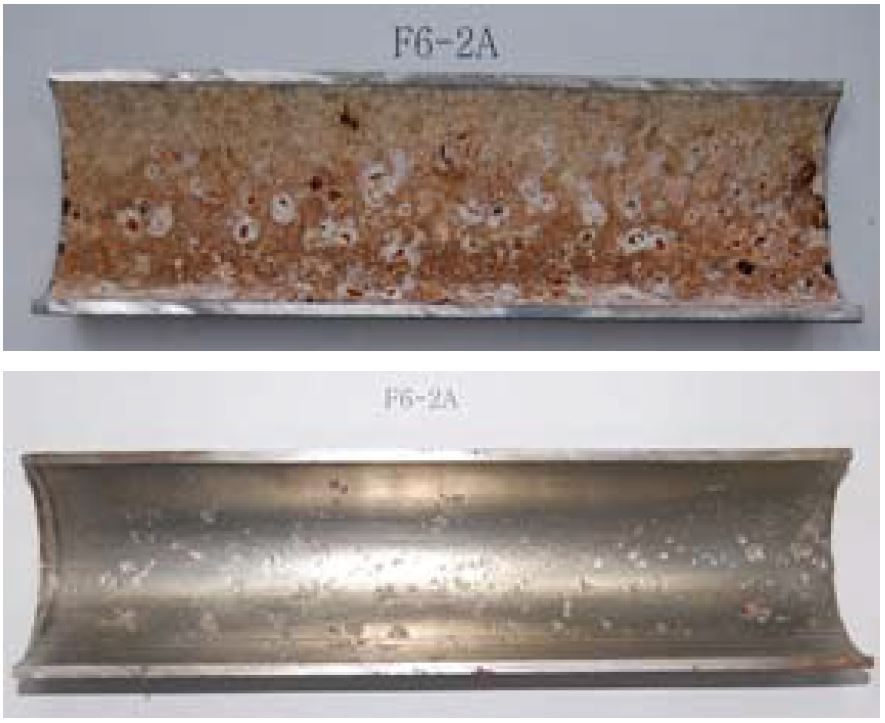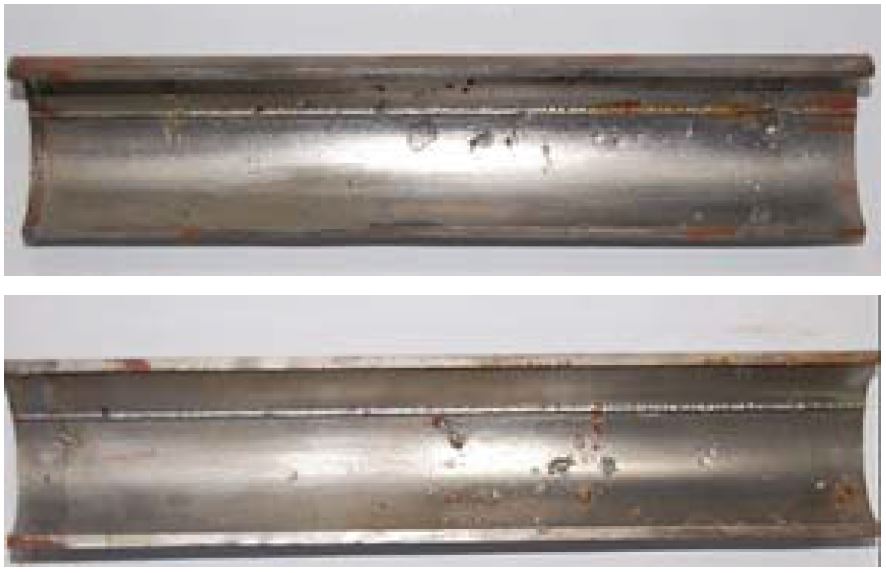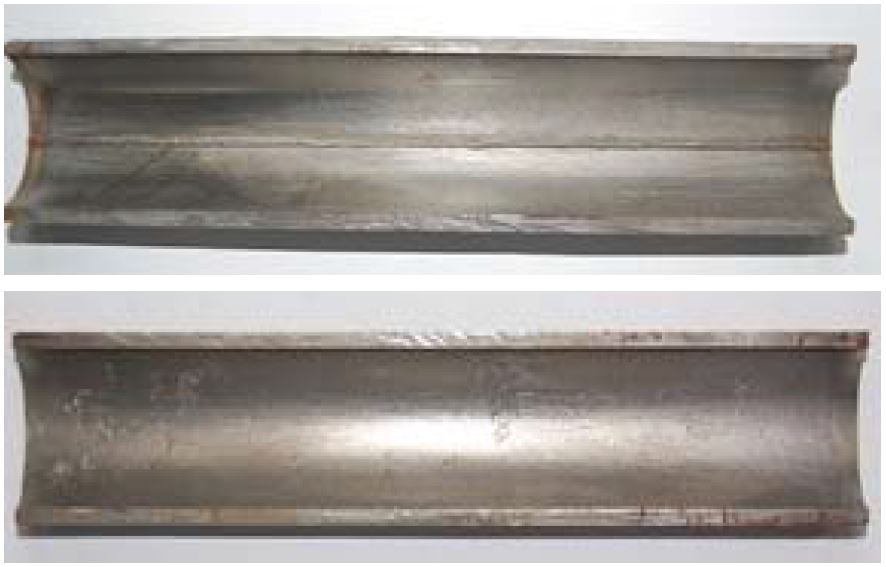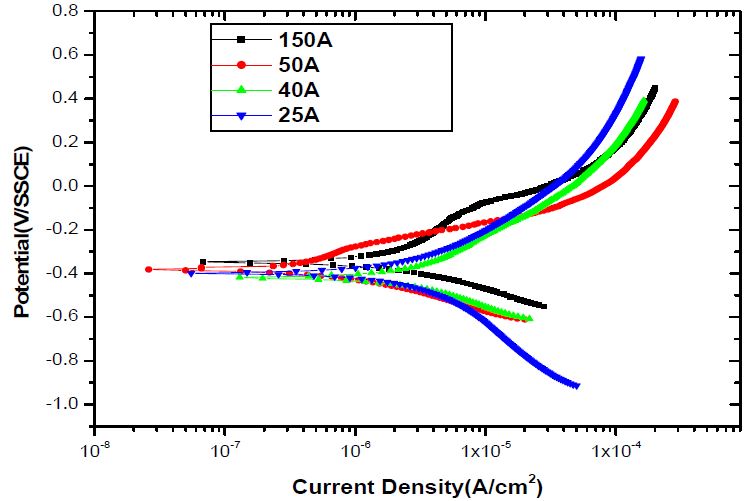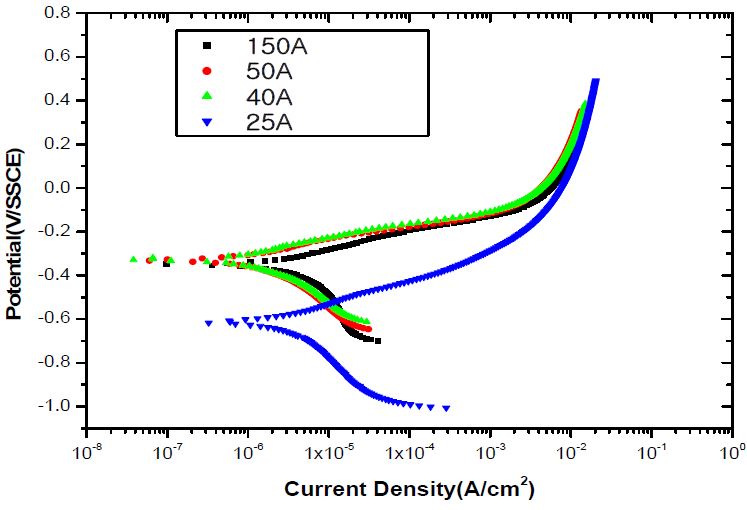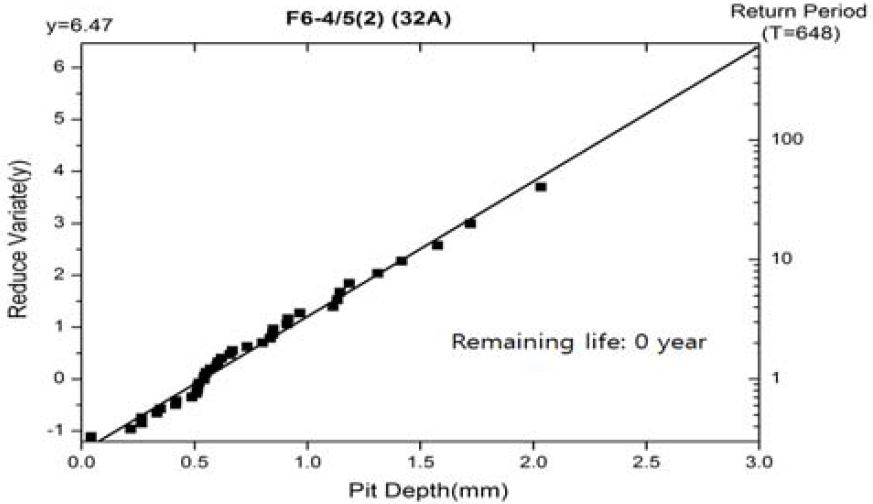
A study on the corrosion evaluation and lifetime prediction of fire extinguishing pipeline in residential buildings
Copyright ⓒ The Korean Society of Marine Engineering
This is an Open Access article distributed under the terms of the Creative Commons Attribution Non-Commercial License (http://creativecommons.org/licenses/by-nc/3.0), which permits unrestricted non-commercial use, distribution, and reproduction in any medium, provided the original work is properly cited.
Abstract
This study is conducted for the evaluation of corrosion and lifetime prediction of fire extinguishing pipelines in residential buildings. The fire extinguishing pipeline is made of carbon steel. Twenty-four samples were selected among all the fire extinguishing pipelines in a building; the selection was based on specimenspositions, pipeline diameters, and pipeline thickness. Analysis was conducted by using the results of visual inspection, electrochemical potentiodynamic anodic polarization test, pitting depth measurements, and extreme value statistics with the Gumbel distribution. The maximum pitting depth and remaining life were statistically predicted using extreme value statistics. During visual inspection, pitting corrosion was observed in several samples. In addition, extreme value statistics demonstrated that there were several pipelines that were very sensitive to pitting corrosion. However, the pitting corrosion was not critical in all the pipelines; thus, it was necessary to change only those pipelines that were severely corroded.
Keywords:
Pitting corrosion, Gumbel distribution, Extreme value statistics, Polarization, Lifetime prediction1. Introduction
Corrosion, which refers to the degradation of materials, is an electrochemical reaction between a metal and its environ-ment [1]. Normally, it is relatively easy to quantify uniform corrosion through the measurement of weight loss and corrosion rate, as compared with localized corrosion, such as pitting and crevice corrosion. In contrast, it is difficult to quantify pitting and crevice corrosion, because the corrosion rate at a specific location mainly depends on the microscopic material and environmental conditions [2][3]. Prediction of pitting corrosion is important to prevent severe corrosion of pipelines, ships, and offshore structures [4][5]. According to a study conducted by Ahammed [6], the damage inflicted on an unprotected pipeline without paint, coating, or cathodic protection is mainly due to pitting corrosion. Normally, the analysis of pitting corrosion is difficult in the case of deep pits. Thus, it is important to predict pitting corrosion using a reliable method [7][8]. For several decades, extreme value statistics has been used to confirm the pitting sensitivity. Extreme value statistics with Gumbel distribution is quite useful and reliable, not only to estimate the maximum pit depth and pitting corrosion, but also to predict the remaining life [9]. The Gumbel distribution can be expressed as
| (1) |
where F(x) represents the cumulative probability of pit depth, λ is the location parameter, and α is the scale parameter. The reduced variate, y, can be represented as
| (2) |
F(y) can be calculated from the following Equation (3):
| (3) |
where i is the ith position of the ordered value of x (descending order), and N is total number of pit samples. In addition, the return period, T, which is a size factor, can be defined as follows.
| (4) |
The return period of a pipeline can also be calculated by the total area of pipeline over the area of selected specimens. After the maximum pit depth is calculated by the equations, the remaining thickness of the specimen can be obtained by deducting the maximum pit depth from the total thickness. The corresponding remaining life of the samples can also be calculated [10].
The main purpose of this study is to investigate not only the type of corrosion and its severity, but also to predict the remaining life of the pipeline. The results from visual inspection, electrochemical potentiodynamic anodic polarization test, pitting depth measurement, and extreme value statistics with Gumbel distribution are used for the analysis.
2. Experimental Method
2.1 Specimen
The structures investigated in our study were each equipped with a fire extinguishing system . The fire extinguishing system was installed on six ground floors and three basement floors. The samples for testing were randomly selected based on visual inspection from outside. Figure 1 shows one of these pipelines that was selected for this experiment. Six different types of samples were selected, considering mainly the pipeline diameter. In this study, the diameters were chosen as 150 mm, 100 mm, 50 mm, 40 mm, 32 mm, and 25 mm; the details are presented in Table 1.
The material of the pipeline was carbon steel, and the chemical composition of the material is presented in Table 2.
In particular, seam pipes made by joining two semi-circular pipes by welding were used in this pipeline; thus, it was expected that corrosion would be observed mainly in the welding zone. The selected specimens were cut to equal lengths of 25 cm. After cutting, the removal of corrosion products from the test specimens was done by chemical cleaning [11].
Firstly, 1000 mL of hydrochloric acid, 20 g of antimony trioxide, and 50 g of stannic chloride were mixed for preparing the cleaning solution. Then, the solution was heated up to 20–25 °C, and the specimens were kept immersed in the solution for 25 min. Figure 2 shows the surface of a specimen before and after the chemical cleaning. As shown in Figure 2, most of the corrosion products were removed by cleaning.
2.2 Experimental Procedure
Visual inspection, pitting depth measurement, and electro-chemical potentiodynamic anodic polarization test were carried out to evaluate the state of corrosion. Extreme value statistics analysis with Gumbel distribution was applied to the analysis of the maximum pitting corrosion depth and prediction of lifetime of the pipeline. Firstly, visual inspection was conducted to confirm the type of corrosion and corroded areas. It was also checked whether the corrosion was highly localized around the heat affected zone (HAZ). The pitting depth was measured using an optical microscope and micro dial gage after the specimens was cleaned by means of chemical cleaning. Twenty pitting points were selected in each specimen. The pitting depth could be measured by adjusting the focal point of microscope.
Electrochemical potentiodynamic anodic polarization tests were carried out using a potentiostat, Reference 600, developed by Gamry Instruments Co. ltd [12]. The reference electrode for the measurement of potential was a silver/silver chloride electrode (SSCE, Ag/AgCl), and the counter electrode was a platinum electrode. The potentiodynamic anodic polarization measurements were conducted in fresh water and 3% salt water to obtain the polarization curve and corrosion current density. Finally, the maximum pit depth and lifetime of the pipeline were statistically estimated using the extreme value statistics.
3. Experimental Results
3.1 Visual Inspection
When the samples were selected, they were divided into two categories: those with highly corroded areas and those with moderate corrosion that is not visible from outside. Thus, that remaining life of these pipelines will be less, as only corroded pipelines are selected.
Figures 3 and 4 show state of the samples on the inner side after chemical cleaning. From Figure 3, it can be confirmed that pitting is the main cause of pipeline corrosion, and that most of the pits are concentrated around the seam, where welding was done. It can also be seen that corrosion has developed from the inner side of the pipeline, and not from outside. This is owing to the fact that the outside of pipelines are coated with paint to prevent corrosion.
It can be seen from the visual inspection that not all samples are severely corroded. Evidence of corrosion cannot be confirmed in several samples, as shown in Figure 4. In addition, the closer the distance of the pipeline from the water supply facilities, the higher the corrosion traces are. It is expected that corrosion may be higher in the areas closer to water supply facilities, since that pipelines in such areas are more likely to be influenced by water and air simultaneously.
3.2 Electrochemical potentiodynamic anodic polarization test
The electrochemical potentiodynamic polarization test is done for characterization of a metal specimen by its current-potential relationship. This test is one of the proven ways to investigate pitting corrosion and passivation tendencies within a few hours. Figures 5 and 6 show the polarization curves of the specimens in fresh water and in 3% salt water, respectively. In Figure 5, all the specimens show similar polarization behavior in terms of correlation between the corrosion potential and current density. The results also show that the specimens do not have a passive behavior, but are in an active state of corrosion. It can also be seen that specimen 25A has a much higher corrosion rate than the other specimens. It must be noted that the anodic behavior of specimen 25A has been affected because of the presence of chloride ions in the salt water, as shown in Figure 6. The reason why all the specimens show a similar trend is that the material of the specimens is the same regardless of the pipeline diameter[13].
3.3 Pitting depth
The pitting depth measurements were carried out on samples from each floor, and the samples of pipeline specimen were selected from 24 locations. The average pitting depth in 10 different positions is presented in Table 3. The average pitting depth for pipeline specimen 32A (having a thickness of 3.0 mm) was the highest among all the specimens, measuring 0.972 mm.
3.4 Extreme value statistics analysis with Gumbel distribution
Figure 7 shows the results of extreme value statistics in the 150 mm diameter pipeline samples taken from all the six floors. First, the maximum pit depth was calculated using the extreme value statistics with Gumbel distribution. The remaining life could be statistically predicted, which can be calculated proportionately. For example, for the pipeline that has been in use for 13 years, the ratio of the maximum pitting depth to the total number of years would represent the annual corrosion rate, from which the remaining life of the pipeline could be predicted by dividing the remaining thickness by the corrosion rate.
From Figure 7, it can be seen that the remaining life is more than 20 years for specimens F6-1A and F6-1B. This is because in the case of the 150 mm diameter samples, the pipeline is relatively thicker, and not all the pits that have formed are deep. As listed in Table 3, some of the specimens have smaller average pitting depth than specimens F6-1A and F6-1B. This clearly demonstrates that not all the pipelines are severely corroded. In contrast, as shown in Figure 8, in the case of 32 mm diameter pipeline samples on the sixth floor(specimens F6-4A, F6-4B, F6-5A, and F6-5B), the remaining life is almost zero, which means that the pipeline needs to be replaced. This can be confirmed from the visual inspection result also. Figure 3 shows the severe corrosion traces observed in the 32 mm diameter samples. From these results, it is clear that only severely corroded pipelines should be considered for replacement.
4. Conclusion
This study was carried out to confirm the state of corrosion of a fire extinguishing pipeline. From the experiment, the following results were obtained.
1) From visual inspection it is confirmed that several pipelines were severely corroded at the inner surface of the pipeline, and not on the outside. In addition, pitting was found to be the major reason for the corrosion, which was extensively formed around the welding seam line.
2) Electrochemical potentiodynamic anodic polarization results showed similar polarization behaviors for all the specimens, since they were all made of carbon steel. The results showed that the corrosion rate was high in the oxidation conditions (such as in salt water), and that all the specimens showed active corrosion status, without passive behavior.
3) The results of pitting depth measurement and extreme value statistics were similar to the results of visual inspection. Several pipelines were found to be extremely weak because of corrosion, and the pitting corrosion may lead to the formation of holes in pipes.
4) Based on visual inspection, electrochemical potentiodynamic anodic polarization tests, pitting depth measurement, and extreme value statistics, it was clear that only severely corroded pipelines need to be replaced.
References
- D. A. Jones, Principles and Prevention of Corrosion, 2nd Edition, Upper Saddle River, New Jersey, the US, Prentice-Hall, (1996).
-
J. J. Vajo, “Application of extreme value analysis to crevice corrosion”, Journal of Corrosion Science, 45(3), p497-498, (2003).
[https://doi.org/10.1016/S0010-938X(02)00129-4]

-
A. J. Betts, and L. H. Boulton, “Crevice corrosion: review of mechanisms, modeling, and mitigation”, British Corrosion Journal, 28(4), p279-296, (1993).
[https://doi.org/10.1179/000705993799156299]

-
S. M. Sharland, “A review of the theoretical modeling of crevice and pitting corrosion”, Journal of Corrosion Science, 27(3), p289-323, (1987).
[https://doi.org/10.1016/0010-938X(87)90024-2]

-
R. E. Melchers, “Extreme value statistics and long-term marine pitting corrosion of steel”, Journal of Probabilistic Engineering Mechanics, 23(4), p482-483, (2008).
[https://doi.org/10.1016/j.probengmech.2007.09.003]

-
M. Ahammed, and R. E. Melchers, “Probabilistic analysis of pipelines subjected to pitting corrosion leaks”, Journal of Engineering Structures, 17(2), p74-75, (1995).
[https://doi.org/10.1016/0141-0296(95)92637-N]

-
D. Rivas, F. Caleyoa, A. Valorb, and J. M. Hallen, “Extreme value analysis applied to pitting corrosion experiments in low carbon steel: Comparison of block maxima and peak over threshold approaches”, Journal of Corrosion Science, 50(11), p3193-3195, (2008).
[https://doi.org/10.1016/j.corsci.2008.08.002]

-
J. A. Jeong, and C. K. Jin, “Lifetime prediction of fire extinguishing pipeline by means of extreme value statistics”, Journal of Applied Mechanics and Materials, 376, p60-64, (2013).
[https://doi.org/10.4028/www.scientific.net/AMM.376.60]

-
G. P. Marsh, I. D. Bland, and K. J. Tayloret, “Statistical study of pit propagation in carbon steel under nuclear waste disposal condition”, British Corrosioin Journal, 23(3), p157-164, (1988).
[https://doi.org/10.1179/000705988798270785]

- T. Shibata, Uhlig Corrosion Handbook, second ed, John Wiley and Sons, New York, p380-382, (2000).
- ISO 8407:2009 Corrosion of metals and alloys – Removal of corrosion products from corrosion test specimens, International Organization for Standardization, (2009).
-
J. H. Jeong, Y. H. Kim, K. M. Moon, M. H. Lee, and J. K. Kim, “Evaluation of the corrosion property on the welded zone of seawater pipe by A.C shielded metal arc welding”, Journal of Korean Society of Marine Engineers, 37(8), p877-885, (2013).
[https://doi.org/10.5916/jkosme.2013.37.8.877]

-
S. J. Kim, S. J. Lee, and S. O. Chong, “Effect of cavitation for electrochemical characteristics in seawater for austenitic 304 stainless steel”, Journal of Korean Society of Marine Engineers, 37(5), p484-492, (2013).
[https://doi.org/10.5916/jkosme.2013.37.5.484]



